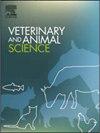现代肉鸡血液生化参数、时间间隔及动态
IF 1.9
Q2 AGRICULTURE, DAIRY & ANIMAL SCIENCE
引用次数: 0
摘要
家禽的血液生化是一个研究不足的领域,需要建立参考区间(RIs)来有效监测不同生命阶段的健康和代谢。为了扩大和完善动物医学中遇到的参数谱,我们追求两个主要目标:第一,建立罗斯308雄性鸡血液RIs的综合谱,第二,调查肉鸡从生命开始的潜在年龄特异性差异。采用35日龄肉鸡共228份血样,测定主要代谢指标的RIs,包括ALT(0.0 ~ 0.4µkat/l)、AST(1.4 ~ 5.7µkat/l)、GMT(0.2 ~ 0.5µkat/l)、ALP(13.3 ~ 281.9µkat/l)、LD(14.2 ~ 112.6µkat/l)、CK(94.9 ~ 925.6µkat/l)、TBili(1.8 ~ 7.3µmol/l)、尿素(0.7 ~ 2.7 mmol/l)、Creat(16.7 ~ 37.7µmol/l)、尿酸(140.0 ~ 594.6µmol/l)、总蛋白(24.7 ~ 37.1 g/l)、白蛋白(13.0 ~ 21.4 g/l)、球蛋白(10.3 ~ 19.0 g/l)、葡萄糖(5.8 ~ 15.1 mmol/l)、胆固醇(2.3-4.1 mmol/l), TG (0.2-1.2 mmol/l)。此外,从第1天到第35天,我们每周监测矿物质、氮、脂肪和能量代谢参数,以评估生化动力学。在大多数参数中发现了显著的年龄相关变化,特别是在孵化后的第一周(P <;0.05)。在整个观察过程中,唯一稳定的指标是肌酐和钾(P >;0.05)。这些发现有助于更深入地了解肉鸡生理学,提高血液检测解释的准确性,并为早期发现代谢紊乱或疾病提供潜力。本文章由计算机程序翻译,如有差异,请以英文原文为准。
The blood biochemical parameters intervals and dynamics in modern broiler chickens
Blood biochemistry in poultry is an understudied area, requiring the establishment of reference intervals (RIs) to monitor health and metabolism effectively across different life stages. To broaden and complete the spectrum of parameters encountered in animal medicine, we pursued two main objectives: first, to establish the comprehensive spectrum of blood RIs for Ross 308 male chickens, and second, to investigate potential age-specific differences in broilers from the onset of their lives. A total of 228 blood samples from 35-day-old broilers were analysed to determine RIs for key metabolism indicators, including ALT (0.0–0.4 µkat/l), AST (1.4–5.7 µkat/l), GMT (0.2–0.5 µkat/l), ALP (13.3–281.9 µkat/l), LD (14.2–112.6 µkat/l), CK (94.9–925.6 µkat/l), TBili (1.8–7.3 µmol/l), Urea (0.7–2.7 mmol/l), Creat (16.7–37.7 µmol/l), Uric Acid (140.0–594.6 µmol/l), Total protein (24.7–37.1 g/l), Albumin (13.0–21.4 g/l), Globulin (10.3–19.0 g/l), Glucose (5.8–15.1 mmol/l), Cholesterol (2.3–4.1 mmol/l), TG (0.2–1.2 mmol/l). Furthermore, we monitored mineral, nitrogen, fat, and energy metabolism parameters weekly from day 1 to day 35 of chick age to assess biochemical dynamics. Significant age-related variations were found in most parameters, particularly during the first week after hatching (P < 0.05). The only stable indicators throughout the observation were creatinine and potassium (P > 0.05). These findings contribute to a deeper understanding of broiler physiology, enhance the precision of blood testing interpretations, and offer the potential for the early detection of metabolic disorders or diseases.
求助全文
通过发布文献求助,成功后即可免费获取论文全文。
去求助
来源期刊

Veterinary and Animal Science
Veterinary-Veterinary (all)
CiteScore
3.50
自引率
0.00%
发文量
43
审稿时长
47 days
 求助内容:
求助内容: 应助结果提醒方式:
应助结果提醒方式:


